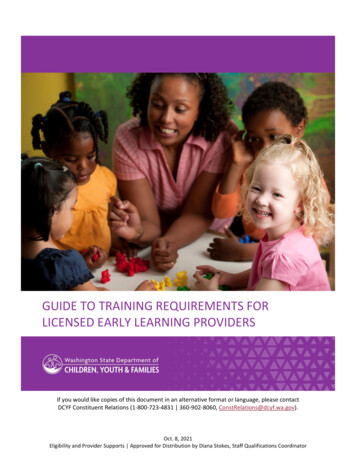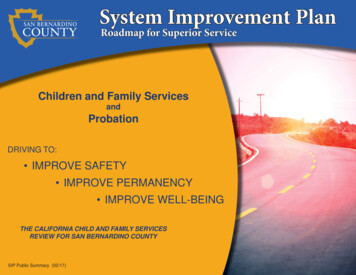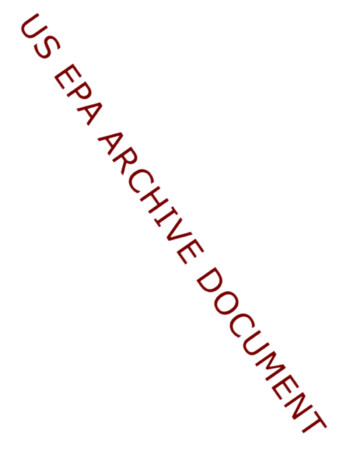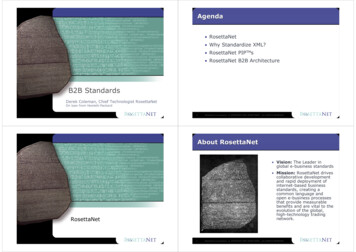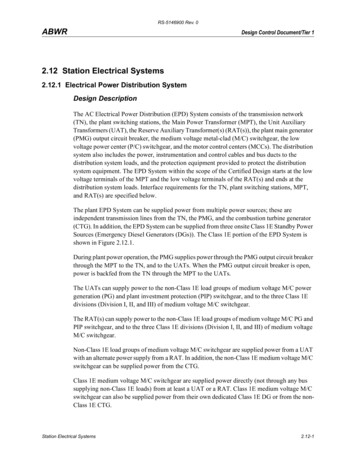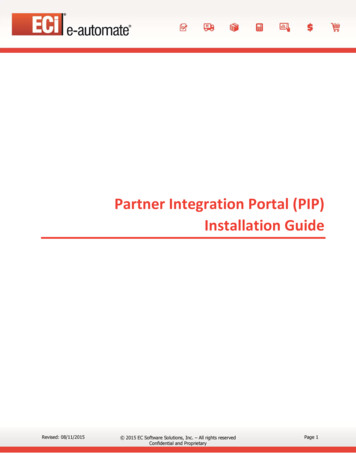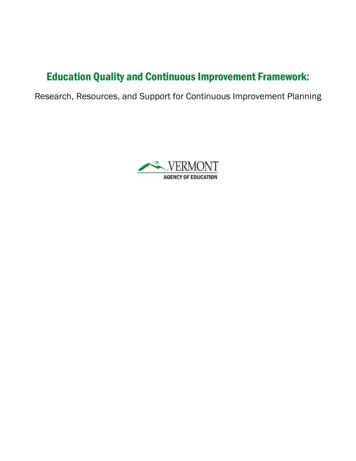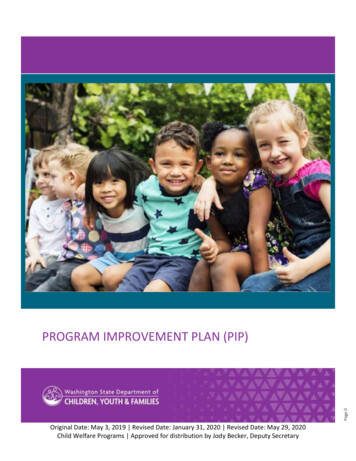
Transcription
Page 0PROGRAM IMPROVEMENT PLAN (PIP)Original Date: May 3, 2019 Revised Date: January 31, 2020 Revised Date: May 29, 2020Child Welfare Programs Approved for distribution by Jody Becker, Deputy Secretary
PROGRAM IMPROVEMENT PLAN (PIP)CONTENTSCONTENTS . 1Introduction . 2PIP and CFSR Crosswalk . 8Goal Area 1: Workforce Development. 11Strategy Overview . 15Goal Area 2: Engagement . 20Strategy Overview . 23Goal Area 3: Assessment and Case Planning . 27Strategy Overview . 33Goal Area 4: Permanency . 42Strategy Overview . 48Page 1Attachments. 56Original Date: May 3, 2019 Revised Date: January 31, 2020 Revised Date: May 29, 2020Child Welfare Programs Approved for distribution by Jody Becker, Deputy Secretary
PROGRAM IMPROVEMENT PLAN (PIP)Washington State Department of Children, Youth, and Families (DCYF) ProgramImprovement PlanState/Territory:WashingtonDate Submitted:May 3, 2019Date Resubmitted:January 31, 2020; Resubmitted with correction February 7, 2020Date Resubmitted:May 29, 2020Date Approved:June 19, 2020PIP Effective Date: July 1, 2020End of PIP Implementation Period: June 30, 2022End of Non-Overlapping Year: June 30, 2023Reporting Schedule and Format:Washington will report progress and outcomes through written reports bi-annually and quarterly conferencecalls. Written reports will be submitted within 30 days of the completion of the quarter and will includeupdates on all strategies and key activities.Original Date: May 3, 2019 Revised Date: January 31, 2020 Revised Date: May 29, 2020Child Welfare Programs Approved for distribution by Jody Becker, Deputy Secretary
IntroductionThe Department of Children, Youth, and Families (DCYF) is Washington State’s child welfare and familyservices agency. DCYF was established in July 2018, bringing together child welfare, early learning, juvenilerehabilitation and juvenile justice into one child and family-focused agency.DCYF’s mission, vision and values are as follows:Mission:Protect children and strengthen families so they flourish.Vision:All Washington’s children and youth grow up safe and healthy—thriving physically, emotionally,and educationally, nurtured by family and community.Values:Inclusion, Respect, Integrity, Compassion, TransparencyOver the next three to five years, DCYF is committed to significantly reducing the number of children in out-ofhome care. To achieve this goal, it is essential to strengthen and expand staff knowledge, skills and supports tokeep children safely in their own homes, to return them safely home as quickly as possible or to achieve othertimely permanency, such as adoption or guardianship.Based on the results of the Child and Family Services Review (CFSR), DCYF has identified four interrelated andcross-cutting practice areas for improvement that the Program Improvement Plan (PIP) addresses: Workforce DevelopmentEngagementAssessment and Case PlanningPermanencyWithin these broad goal areas, strategies and activities focus on strengthening supervisory skill andknowledge; establishing a framework for ongoing quality child, youth and parent engagement; enhancingsafety assessment and provision of safety-related services; and achieving timely permanency by leveragingengagement for effective case planning. DCYF believes strong practice in these areas will improve outcomesfor children and families, address disproportionality and inequity within the child welfare system and achievethe agency goal of safely reducing the number of children in out-of-home care. Strategies and activities in allfour goal areas were conceptualized to address a cross-cutting root cause that emerged during PIPdevelopment work: DCYF struggles with ongoing implementation and support for practice initiatives and processes,resulting in practice drift and varied practice and performance across the state.Page 2To further support the PIP goals, DCYF has worked to align strategies with those in other initiatives activewithin the Department. These include the Permanency from Day One (PFD1) grant, the Family First PreventionServices Act (FFPSA), the Court Improvement Plan (CIP) and the Quality Improvement Center-WorkforceDevelopment (QIC-WD) grant.Original Date: May 3, 2019 Revised Date: January 31, 2020 Revised Date: May 29, 2020Child Welfare Programs Approved for distribution by Jody Becker, Deputy Secretary
Washington’s CFSR ResultsWashington participated in Round 3 of the CFSR from April 2018 through September 2018 through a state-ledreview. The review included an analysis of 130 cases from 18 offices across the six regions statewide. Of these130 cases, 95 were foster care and 35 were in-home, including 12 Family Assessment Response (FAR),Washington State’s differential response pathway. Additional information was obtained from interviewsconducted by the Children’s Bureau with approximately 200 stakeholders in May 2018.The results of the CFSR determined that Washington State is not in substantial conformity with the sevenOutcomes, which include Safety Outcomes 1 and 2, Permanency Outcomes 1 and 2 and Well-Being Outcomes1, 2 and 3. Washington was found to be in substantial conformity with three systemic factors: QualityAssurance System, Agency Responsiveness to the Community and Foster and Adoptive Parent Licensing,Recruitment and Retention. The Systemic Factors of Statewide Information System, Case Review System, Staffand Provider Training and Service Array and Resource Development, were not in substantial conformity. Theprimary outcomes for focus within Washington’s PIP are Safety Outcome 1, Safety Outcome 2, PermanencyOutcome 1 and Well-Being Outcome 1. The goals, strategies and activities identified in the PIP will alsoaddress the other Outcomes and Systemic Factors that have been identified as not being in substantialconformity.Safety Outcome 1: Children are, first and foremost, protected from abuse and neglect.86% Substantially AchievedWashington demonstrated strong performance overall related to Safety Outcome 1. Analysis of data revealedthat when children were not seen within the required timeframes, extensions were not consistentlydocumented, and approved extensions were not valid per policy. When extensions were approved, follow-updid not occur to ensure the child was seen timely. Furthermore, victims were not seen for each intake whenmultiple intakes occurred within close timeframes and victims assigned to Child and Family Welfare Services(CFWS) were not consistently seen per policy.Safety Outcome 2: Children are safely maintained in their homes whenever possible and appropriate.64% Substantially AchievedOverall performance for foster care cases was stronger than in-home and FAR cases. Item 2, (Services toprevent removal or re-entry into care), was a strength in 69% of the foster care cases compared to 80% of thein-home services cases and 33% of the FAR cases. Item 3, (Risk and safety assessment and management),rated as a strength in 68% of the foster care cases, 57% of the in-home cases and 50% of the FAR cases.Page 3Based on the CFSR qualitative data, informal assessments occurred while children were in out-of-home care.In the majority of foster care cases where assessments did not occur, the lack of assessment occurred prior toplacement or after children returned home to their parents. Areas of improvement related to service provisionincluded the overall provision of services and the matching of services specific to safety threats, includingsubstance use and domestic violence services.Original Date: May 3, 2019 Revised Date: January 31, 2020 Revised Date: May 29, 2020Child Welfare Programs Approved for distribution by Jody Becker, Deputy Secretary
Permanency Outcome 1: Children have permanency and stability in their living situations.17% Substantially AchievedWithin Permanency Outcome 1, Placement Stability (Item 4) was rated a strength in 68% of the cases,Permanency Goal for Child (Item 5) was a strength in 60% of the cases and Timely Permanency (Item 6) was astrength in 23% of the cases. Areas of improvement related to permanency included the timely change ofpermanent plans related to change in circumstances, timely filing of termination petitions or documentationof compelling reasons, timely completion of kinship home studies and timely reunification when safety threatsno longer existed or could be mitigated through a safety plan.Well-Being Outcome 1: Families have enhanced capacity to provide for their children’s needs.47% Substantially AchievedFor Well-Being Outcome 1, performance was similar across all case types with foster care cases rated at 46%,in-home cases rated at 48% and FAR cases rated at 50%. Within the sub-items, the greatest areas forimprovement included the following: Assessment of children in FAR cases (rated at 64% compared to 78% for in-home cases and 81% forfoster care cases)Assessment of parents across all case types for both parents (58% for foster care cases, 61% for inhome cases and 55% for FAR cases)Involvement of both parents in case planning (67% for mothers and 66% for fathers)Caseworker visits with the child in FAR cases (50% rated a strength)Caseworker visits with parents across all case types (51% for foster care, 61% for in-home and 50% forFAR)The lack of consistent visits with children and parents and comprehensive meaningful conversations impactedboth the ability to complete quality assessments and to engage children and parents in the development ofcase plans tailored to meet their individual needs. A lack of consistent efforts to locate absent parents alsoimpacted parent visits.Developing the PIP DCYF staffDCYF leadershipTribesParentsYouthJudicial officersAdministrative Office of the Courts (AOC)Parent and youth representation programsOriginal Date: May 3, 2019 Revised Date: January 31, 2020 Revised Date: May 29, 2020Child Welfare Programs Approved for distribution by Jody Becker, Deputy SecretaryPage 4DCYF engaged the following groups at the state, regional and local levels in problem identification, root causeanalysis and the development of goals, strategies and activities:
Assistant Attorneys General (AAG)University of Washington’s Alliance for Child Welfare Excellence (“Alliance” - DCYF’s contractedtraining entity)CaregiversOther stakeholders and community partnersStakeholder groups used data for discussion and analysis. DCYF brought this analysis forward to more focusedteams that met in July, September, October and December 2019 and January 2020 to refine the problemidentification, root causes and strategies, and finalize the PIP (attachment A). Throughout PIP development,DCYF endeavored to align strategies with work occurring in other efforts across the Department, includingPFD1, FFPSA, CIP and QIC-WD. Additionally, the Capacity Building Center for the States and the CapacityBuilding Center for the Courts provided technical assistance for the PIP development process.A consistent theme throughout the groups and across all of the identified practice areas was the need tostrengthen core child welfare practice and “get back to basics.” The various groups engaged in data analysisand root cause development identified that there is an inconsistent emphasis, support and accountability overtime for ongoing implementation and integration of practices, policies and procedures, resulting in practicedrift and varied performance across the state. There is also a tendency to address the practice elements orneeded improvements in isolation, rather than as integrated parts of the larger child welfare system. Thisresults in a loss of efficiency and integration – for example, focusing on needing to complete a monthly visit asa standalone task rather than considering and emphasizing how that meeting can be an opportunity forfocused engagement to address safety, service needs and permanency.DCYF’s PIP focuses on reinforcing and enhancing the current tools and structure available to our staff;streamlining, aligning and integrating processes; and providing practice support with the intent of recapturingand strengthening core social work practice to support positive outcomes for children and families. The CFSRcase review and established qualitative feedback process will be a source of measurement for practiceimprovements. Workforce Development: the strategies and activities identified within this goal area providesupervisors and caseworkers with clear practice expectations, priorities, skills and competencies toachieve the Engagement, Assessment and Case Planning and Permanency goals. Skillful supervisionenhances caseworker competency and support, which in turn leads to better individual and familyassessment and engagement and ultimately to improved child and family safety, permanency and wellbeing. Supervisors and staff will be empowered to utilize data as a tool to inform and drive clinicalpractice and create an atmosphere of intentional supervision and ongoing practice improvement.Implementation of a supervisory coaching model and technical assistance and support to supervisorswill sustain improved practice. DCYF’s work through the QIC-WD grant was incorporated into theassessment and identification of strategies in this area.Original Date: May 3, 2019 Revised Date: January 31, 2020 Revised Date: May 29, 2020Child Welfare Programs Approved for distribution by Jody Becker, Deputy SecretaryPage 5Based on the analysis of the data and key participant engagement, four interrelated and cross-cutting goalswere identified for the PIP. These encompass the social work practice performance improvements andsupports needed to improve outcomes for children and families. The four goal areas are as follows:
Engagement: the strategies and activities identified within this goal area support and maintainongoing, authentic engagement with children, youth, parents and caregivers. Development of anengagement framework with an emphasis on monthly visits with parents and children is the primarystrategy focus. This includes staff support for engaging parents whose whereabouts are unknown, whoare incarcerated or who are reluctant to engage. Successful engagement connects to the Assessmentand Case Planning and Permanency goal areas by supporting thorough, timely assessments of safety,provision of appropriate services and development of meaningful, individualized case plans. Strategieswithin the Workforce Development goal area that target supervisor knowledge and skill support theimplementation and ability to sustain the practice identified in this section.Assessment and Case Planning: the strategies and activities within this goal area focus on practicerelated to safety. They address timely responses to allegations of child abuse and neglect; timely,accurate assessments of safety; identification and implementation of services and the development ofindividualized case plans in partnership with families. Building on the work identified within theEngagement goal area, caseworkers will utilize timely, frequent engagement with families to assesschild safety accurately at critical junctures throughout the life of a case. They will be able to articulatesafety threats and risks to families, courts, providers and other key stakeholders and will partner withfamilies to identify services and resources that mitigate safety concerns. The Assessment and CasePlanning strategies also connect to the Permanency goal area in that accurate safety assessment andprovision of tailored services contribute to timely permanency. Workforce strategies further intersectwith Assessment and Case Planning in that a skilled and supported workforce is better equipped toassess safety and develop meaningful case plans through engagement with families. The work donewithin this goal area aligns with the work identified in DCYF’s FFPSA prevention plan.Permanency: the strategies and activities identified within this goal area address practice areas thatimpact children's and youth’s need for timely permanency. The strategies build upon those identifiedwithin the Engagement and Assessment and Case Planning goal areas in that engagement of children,parents and key stakeholders supports permanency outcomes by identifying appropriate permanentplans and services that target child safety. The Permanency strategies support timely reunification andother permanency through an accurate application of the Safety Framework and structuredpermanency planning meetings. Additional strategies include providing peer support to parents,ensuring that termination petitions are filed timely and completing home studies for kin moreefficiently. The strategies within this section align and integrate with the work done under the PFD1grant, as well as the CIP. As with other goal areas, Workforce Development strategies support theinitiatives outlined in the Permanency goal area by enhancing supervisors’ skills to coach topermanency.Work to identify root causes, goal areas and strategies led to a cross-cutting, systemic root cause:DCYF is unable to consistently sustain practice initiatives and processes following initialimplementation, resulting in practice drift that has contributed to inconsistent social work practicewithin and across regions.Page 6 Original Date: May 3, 2019 Revised Date: January 31, 2020 Revised Date: May 29, 2020Child Welfare Programs Approved for distribution by Jody Becker, Deputy Secretary
Over time, initiation of several practice improvement efforts – such as the implementation of the SafetyFramework – have exhibited DCYF’s inability to maintain model fidelity. In addition, DCYF has become focusedon compliance-based tasks rather than the quality of social work practice. Addressing this root cause isembedded in all four of the goal areas, along with additional goal-specific root causes.DCYF has submitted its FFPSA Prevention Plan, which includes an array of evidence-based services includingFunctional Family Therapy, Motivational Interviewing, Multi-Systemic Therapy, Nurse-Family Partnership,Parents as Teachers, Child-Parent Psychotherapy, Homebuilders, Incredible Years, SafeCare, and Triple P thatwill contribute to the achievement of PIP goals. While some of these services are currently available,expanding the array and availability support improvements needed in the Service Array Systemic Factor byaddressing gaps and providing individualized services to support children remaining home with their parents.Within the plan, DCYF identified CPS FAR, CPS investigation and In-Home Family Voluntary Services (FVS), aswell as children on trial-return home, among the candidacy groups.Page 7Finally, DCYF recognizes the importance of an effective practice model that supports the timely achievementof safety, permanency and well-being outcomes and provides the foundation to develop a more competentand supported workforce. Over the course of the next five years, under the Child and Family Services Plan(CFSP), DCYF will re-evaluate its current practice model, Solution-Based Casework (SBC), for relaunch orreplacement. Under FFPSA, DCYF intends to implement Motivational Interviewing (MI), which will beincorporated into the practice model and will support and align with strategies identified within the PIP.Implementation of MI will also impact the Staff and Provider Training Systemic Factor as it will require ongoingtraining to sustain and develop the skills. The goal is to have MI used at each encounter with families. This willrequire community-based service providers, caseworkers and supervisors to be trained in the use of MI.Supervisors will provide critical support to caseworkers in using MI in the development and monitoring of theFFPSA Prevention Plan. Community-based service providers will use MI in developing the assessment anddelivering services. While the practice model is not directly addressed as part of the PIP, the intent is that theareas of focus and strategies identified within the PIP will strengthen core child welfare practice, which willalign with and support core components of any established practice model.Original Date: May 3, 2019 Revised Date: January 31, 2020 Revised Date: May 29, 2020Child Welfare Programs Approved for distribution by Jody Becker, Deputy Secretary
PIP and CFSR CrosswalkPIP Goal/StrategyGoal 1: Workforce DevelopmentStrategy 1.1: Improve supervisory proficiency inutilizing individual staff and unit outcome indicatorsas a tool for guiding clinical supervision andachieving improved agency outcomes.Strategy 1.2: Implement an evidence-informedcoaching model with AAs and supervisors to supporttheir staff in ongoing learning and application ofskills.Strategy 1.3: Implement a structure for formalcaseworker supervision that focused on programspecific critical decision-making skills and clinicalsupport and guidance for staff.Strategy 1.4: Improve functionality and increasecaseworker use of Child Location Application toensure timely entry of placement so the currentlocation of every child in out-of-home care is known.Goal 2: EngagementSystemic Factor: Staff and Provider TrainingSystemic Factor: Staff and Provider TrainingSystemic Factor: Statewide Information SystemPermanency Outcome 1Permanency Outcome 2Well-being Outcome 1Well-being Outcome 2Systemic Factor: Case Review SystemPermanency Outcome 1Permanency Outcome 2Well-being Outcome 1Well-being Outcome 2Systemic Factor: Case Review SystemWell-being Outcome 1Well-being Outcome 1Page 8Strategy 2.1: Establish and sustain a consistentengagement framework that supports caseworkersto be intentional with their contacts and visits,increasing the quality of visits for parents andchildren and improving caseworker efficiency.Strategy 2.2: Implement monthly and quarterlyqualitative and quantitative data review feedbackcycles for frequent and quality contacts withchildren and families to highlight performance andinform program and practice improvements.Strategy 2.3: Implement consistent statewideprocess, guidance and resources for engagingparents whose whereabouts are unknown or whoare incarcerated.CFSR Outcome/Systemic Factor AddressedSystemic Factor: Staff and Provider TrainingSystemic Factor: Statewide Information SystemSystemic Factor: Staff and Provider TrainingOriginal Date: May 3, 2019 Revised Date: January 31, 2020 Revised Date: May 29, 2020Child Welfare Programs Approved for distribution by Jody Becker, Deputy Secretary
Strategy 3.1: Revise policy, provide guidance andimplement consistent QA/CQI processes to ensuretimely initial assessments of child safety.Strategy 3.2: Implement support for consistentapplication of the Safety Framework across all casetypes by aligning safety-related assessment and caseplanning activities, revising tools to support practice,and establishing an ongoing QA and consultationprocess.Strategy 3.3: Implement a new, structured caseplanning framework for in-home and FAR cases toimprove assessment and engagement with parentsand children and to better support identification andprovision of services that target family needs.Strategy 3.4: Implement support structure toensure timely completion of Family Team DecisionMaking (FTDM) and integration of Safety Frameworkto support placement decision-making prior to filingdependency petitions to keep children safely athome with their parents to establish clear conditionsfor return home.Strategy 3.5: Hold case consultations prior to filingdependency petitions (after FTDMs) and on complexcases to strengthen practice-related decisionmaking, development of effective safety plans, andprovision of individualized safety-related services forkeeping children safely with their parents.Strategy 3.6: Increase knowledge of screening andassessment; implement data collection and tracking;and monitor follow through to ensure childrenreceive adequate and timely services to meet theirphysical and dental health needs.Strategy 3.7: Improve availability and access toservices to address children, youth, and theirfamily’s behavioral health through data collection,analysis, and integration with systemic partners.Goal 4: PermanencySafety Outcome 1Safety Outcome 2Well-Being Outcome 3Systemic Factor: Service ArraySafety Outcome 1Safety Outcome 2Safety Outcome 2Systemic Factor: Service ArraySafety Outcome 2Safety Outcome 2Well-being Outcome 3Well-being Outcome 3Systemic Factor: Service ArrayPermanency Outcome 1Permanency Outcome 2Well-being Outcome 1Systemic Factor: Case Review SystemOriginal Date: May 3, 2019 Revised Date: January 31, 2020 Revised Date: May 29, 2020Child Welfare Programs Approved for distribution by Jody Becker, Deputy SecretaryPage 9Goal 3: Assessment and Case Planning
Permanency Outcome 1Systemic Factor: Case Review SystemPermanency Outcome 1Systemic Factor: Case Review SystemPermanency Outcome 1Systemic Factor: Case Review SystemPermanency Outcome 1Well-being Outcome 1Systemic Factor: Case Review SystemPermanency Outcome 1Permanency Outcome 2Page 10Strategy 4.1: Establish dedicated permanencyplanning facilitators to coordinate, facilitate, andtrack timely and comprehensive permanencyplanning meetings.Strategy 4.2: DCYF staff and court partners willdevelop, understand, and articulate consistentlanguage regarding DCYF’s Safety Framework andimplement changes in caseworker and court practicerelated to the Safety Framework.Strategy 4.3: AGO, in collaboration with DCYF, willimplement a statewide process for timely referraland filing of termination petitions that clearlydelineate expectations, roles, and responsibilities forDCYF and AGO staff.Strategy 4.4: Increase earlier and more frequentparent engagement in the child welfare process andimprove outcomes by strengthening the use of P4P.Strategy 4.5: Improve timely referrals for andcompletion of home studies.Original Date: May 3, 2019 Revised Date: January 31, 2020 Revised Date: May 29, 2020Child Welfare Programs Approved for distribution by Jody Becker, Deputy Secretary
Goal Area 1: Workforce DevelopmentWashington seeks to design and implement a supervisory approach and administrative tools that lead tosupervisors’ development of skills and enhanced capacity to provide clinical supervision and support. Usingthese enhanced skills, supervisors will coach casework staff to strengthen caseworker skills and furtherdevelop critical thinking in order to improve outcomes for children, youth, and families and to develop andretain workers who will invest in child welfare as a career.Outcomes and Items Addressed or Impacted:The strategies in the workforce section are intended to influence performance on multiple CFSR Outcomesand Systemic Factors with the focus on Staff and Provider Training and Statewide Information System SystemicFactors.Data Sources Staff surveys (2015, 2017, 2019)Trends observed in relation to Region 2 Enhanced Supervisory Coaching effortTargeted Permanency Reviews (2018-2019)Child and Family Services Review (CFSR) Results, including Stakeholder Interviews (2018)Regional Administrator (RA)/Deputy Regional Administrator (DRA) data analysis/root cause/strategydevelopment meeting (July 2019)In-person Capacity Building Center for States/Children’s Bureau TA meeting (September 2019)Area Administrator (AA), Supervisor, QA/CQI data analysis/root cause/strategy development meeting.Supported by Capacity Building Center for States (October 2019)Court system/partner PIP development meeting. Facilitated by Capacity Building Center for Courts.Included Capacity Building Center for States and Children’s Bureau. (December 2019)Case Review Deep Dives (2017-2018) 70% of staff said their supervisor was a factor that made them want to stay with the agency (2015retention survey).56% indicated that stress level was a factor that did not make them want to stay. Comments reflectedthemes of overwhelming stress and a desire for more support toward emotional health, self-care andwellness (2015 retention survey).43% (842/1940) of staff reported that they were “satisfied” or “very satisfied” with well-being, definedas how their work environment affects their physical, social, and emotional health (2017 staff survey).Original Date: May 3, 2019 Revised Date: January 31, 2020 Revised Date: May 29, 2020Child Welfare Programs Approved for distribution by Jody Becker, Deputy SecretaryPage 11Summary of FindingsStaff SurveysDCYF revi
prevent removal or re-entry into care), was a strength in 69% of the foster care cases compared to 80% of the in-home services cases and 33% of the FAR cases. Item 3, (Risk and safety assessment and management), rated as a strength in 68% of the foster care cases, 57% of the in-home cases and 50% of the FAR cases.
